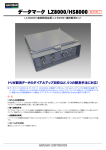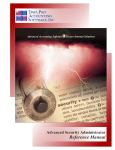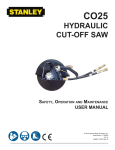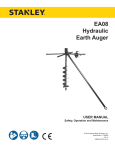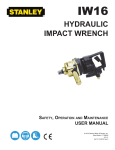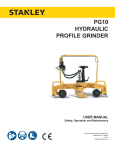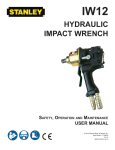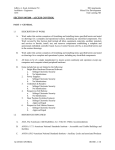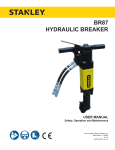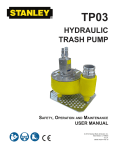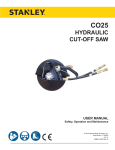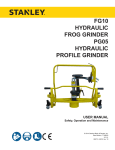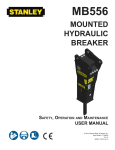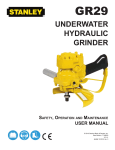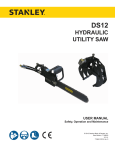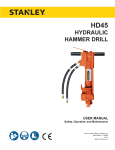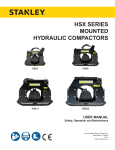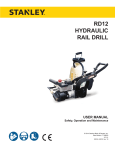Download HS22000 - Stanley Hydraulic Tools
Transcript
HS22000 MOUNTED HYDRAULIC COMPACTOR Safety, Operation and Maintenance USER'S MANUAL © 2011 Stanley Black & Decker, Inc. New Britain, CT 06053 U.S.A. 65771 10/2012 Ver. 5 TABLE OF CONTENTS CERTIFICATE OF CONFORMITY.........................................................................................................................4 SAFETY SYMBOLS................................................................................................................................................5 SAFETY PRECAUTIONS.......................................................................................................................................6 TOOL STICKERS & TAGS.....................................................................................................................................7 OPERATION...........................................................................................................................................................8 PREOPERATION PROCEDURES......................................................................................................................8 DAILY MAINTENANCE CHECKS.......................................................................................................................8 PRE-INSTALLATION INSTRUCTIONS...............................................................................................................8 LOW-TEMPERATURE WARM-UP PROCEDURE..............................................................................................8 GENERAL INSTRUCTIONS................................................................................................................................9 COMPACTION....................................................................................................................................................9 GENERAL............................................................................................................................................................9 SLOPE TECHNIQUE..........................................................................................................................................9 SOIL TESTING..................................................................................................................................................10 DRIVING............................................................................................................................................................10 TROUBLESHOOTING..........................................................................................................................................11 DEFINITION OF TERMS......................................................................................................................................14 SPECIFICATIONS................................................................................................................................................15 TORQUE TABLE..................................................................................................................................................15 HS22000 PARTS ILLUSTRATION........................................................................................................................16 HS22000 PARTS LIST..........................................................................................................................................17 IMPORTANT To fill out a Product Warranty Recording form, and for information on your warranty, visit Stanleyhydraulic.com and select the Warranty tab. (NOTE: The warranty recording form must be submitted to validate the warranty). SERVICING THE STANLEY HYDRAULIC compactor. This manual contains safety, operation, and routine maintenance instructions. Stanley Hydraulic Tools recommends that servicing of hydraulic tools, other than routine maintenance, must be performed by an authorized and certified dealer. Please read the following warning. WARNING SERIOUS INJURY OR DEATH COULD RESULT FROM THE IMPROPER REPAIR OR SERVICE OF THIS TOOL. REPAIRS AND / OR SERVICE TO THIS TOOL MUST ONLY BE DONE BY AN AUTHORIZED AND CERTIFIED DEALER. For the nearest authorized and certified dealer, call Stanley Hydraulic Tools at the number listed on the back of this manual and ask for a Customer Service Representative. 3 DECLARATION OF CONFORMITY DECLARATION OF CONFORMITY ÜBEREINSTIMMUNGS-ERKLARUNG DECLARATION DE CONFORMITE CEE DECLARACION DE CONFORMIDAD DICHIARAZIONE DI CONFORMITA Hydraulic Tools ______________________________________________________________________ I, the undersigned: Ich, der Unterzeichnende: Je soussigné: El abajo firmante: lo sottoscritto: Weisbeck, Andy Surname and First names/Familiennname und Vornamen/Nom et prénom/Nombre y apellido/Cognome e nome hereby declare that the equipment specified hereunder: bestätige hiermit, daß erklaren Produkt genannten Werk oder Gerät: déclare que l’équipement visé ci-dessous: Por la presente declaro que el equipo se especifica a continuación: Dichiaro che le apparecchiature specificate di seguito: 1. Hydraulic Powered Compaction Machine Category: Kategorie: Catégorie: Categoria: Categoria: 2. Make/Marke/Marque/Marca/Marca Stanley 3. Type/Typ/Type/Tipo/Tipo: HS3000, HS6000, HS8000, HS11000, HS22000 4. Serial number of equipment: Seriennummer des Geräts: Numéro de série de l’équipement: Numero de serie del equipo: Matricola dell´attrezzatura: 5. Mass/Masse/Masse/Masa/Massa All 168/998 kg Has been manufactured in conformity with Wurde hergestellt in Übereinstimmung mit Est fabriqué conformément Ha sido fabricado de acuerdo con E’ stata costruita in conformitá con Directive/Standards Richtlinie/Standards Directives/Normes Directriz/Los Normas Direttiva/Norme No. Nr Numéro No n. Approved body Prüfung durch Organisme agréé Aprobado Collaudato EN ISO EN ISO Machinery Directive 12100-1:2009 12100-2:2009 2006/42/EC:2006 Self 6. Special Provisions: None Spezielle Bestimmungen: Dispositions particulières: Provisiones especiales: Disposizioni speciali: 8. Representative in the Union: Patrick Vervier, Stanley Dubuis 17-19, rue Jules Berthonneau-BP 3406 41034 Blois Cedex, France. Vertreter in der Union/Représentant dans l’union/Representante en la Union/Rappresentante presso l’Unione Done at/Ort/Fait à/Dado en/Fatto a Stanley Hydraulic Tools, Milwaukie, Oregon USA Signature/Unterschrift/Signature/Firma/Firma Position/Position/Fonction/Cargo/Posizione Engineering Manager 4 1/6/2011 Date/Datum/le/Fecha/Data 1-6-11 SAFETY SYMBOLS Safety symbols and signal words, as shown below, are used to emphasize all operator, maintenance and repair actions which, if not strictly followed, could result in a life-threatening situation, bodily injury or damage to equipment. This is the safety alert symbol. It is used to alert you to potential personal injury hazards. Obey all safety messages that follow this symbol to avoid possible injury or death. DANGER This safety alert and signal word indicate an imminently hazardous situation which, if not avoided, will result in death or serious injury. WARNING This safety alert and signal word indicate a potentially hazardous situation which, if not avoided, could result in death or serious injury. CAUTION This safety alert and signal word indicate a potentially hazardous situation which, if not avoided, could result in death or serious injury. CAUTION This signal word indicates a potentially hazardous situation which, if not avoided, may result in property damage. NOTICE This signal word indicates a situation which, if not avoided, will result in damage to the equipment. IMPORTANT This signal word indicates a situation which, if not avoided, may result in damage to the equipment. Always observe safety symbols. They are included for your safety and for the protection of the tool. LOCAL SAFETY REGULATIONS Enter any local safety regulations here. Keep these instructions in an area accessible to the operator and maintenance personnel. 5 SAFETY PRECAUTIONS Tool operators and maintenance personnel must always comply with the safety precautions given in this manual and on the stickers and tags attached to the tool and hose. These safety precautions are given for your safety. Review them carefully before operating the tool and before performing general maintenance or repairs. Supervising personnel should develop additional precautions relating to the specific work area and local safety regulations. If so, place the added precautions in the space provided in this manual. The HS22000 Mounted Hydraulic Compactor’s will provide safe and dependable service if operated in accordance with the instructions given in this manual. Read and understand this manual and any stickers and tags attached to the tool and hoses before operation. Failure to do so could result in personal injury or equipment damage. Check the rule and regulations at your location. The rules might include an employer's work safety program. Regulations may identify hazards such as working around utility supply lines or hazardous slopes. BE THOROUGHLY TRAINED BEFORE OPERATING THE UNIT ALONE • Operator training must start in an area without bystanders and use all the controls until he/she can control the machine fully under the conditions of the work area. • When learning to operate a machine, do so at a slow pace. KNOW THE WORK CONDITIONS • The operator must know any prohibited uses or work areas for the machine. For example, excessive slopes and poor or dangerous terrain conditions must be avoided. OBEY SAFETY RULES • Replace all faulty or leaking hydraulic hoses or fittings before further operation. • Always operate the compactor with backhoe outriggers firmly on the surface. The compactor weighs more than the bucket. Position the compactor with caution. • Travel with the compactor in full tuck (transport) position only. • Never operate with any person near the compactor or between the compactor and operator. • Operate the compactor in properly shored trenches and excavations. Do not allow personnel to work in the excavation near compactor operation. • Make sure all controls (levers and pedals) are in the NEUTRAL position before starting the carrier. • Wear safety eye protection, hard hat, and safety foot protection while operating the compactor. • Operate the carrier or compactor from the operator's seat ONLY. Make sure the seat belt is securely fastened before activating any controls. • Make certain that no other personnel are within the arc prescribed by the movement of the stabilizers, front bucket or backhoe boom. • Keep hands and feet on the controls at all times when the machine is running. • Before leaving the operator's seat, always lower the loader arms and the backhoe boom. • NEVER leave the machine with the engine running. ALWAYS ENGAGE THE PARKING BRAKE. • Stop the engine before attempting to make any repairs or adjustments to either the carrier or compactor. • To avoid personal injury or equipment damage, all tool repair, maintenance and service must only be performed by authorized and properly trained personnel. 6 TOOL STICKERS & TAGS 22493 Model Decal 40483 CE Spec Plate 47351 Composit Warning 09164 Stanley Logo Decal 47352 Lift Point Decal 7 OPERATION Check the carrier fuel filter. Replace the filter if dirty or deteriorated. PREOPERATION PROCEDURES When tightening pipe threads, be careful that any sealant used (Teflon ® tape, etc.) does not enter the hydraulic system. Foreign matter introduced into the system may damage hydraulic valves, motors and pumps. DAILY MAINTENANCE CHECKS Check for loose or missing fasteners. Tighten or replace as needed. Refer to Torque Specifications in the Specification section of this manual. Follow instructions to install the Stanley priority valve in the carrier hydraulic system. the warranty is in effect only if the valve and compactor are installed as outlined in the valve kit installation instructions. Major modifications or equipment substitution will cause the warranty to be void unless prior engineering approval has been granted by Stanley Hydraulic Tools. Check to be certain that the flow control valve on the carrier is set to the proper flow for the compactor. Refer to the Specification section of this manual. Check shock mounts for cracks or tears. Rotate shock mounts 180° when fatigue tears begin to show at top outer crease of the shock mount. This will prolong the life of the shock mount. The Stanley priority valve is a metering (to the hydraulic tool) pressure compensating valve that controls the flow to the attachment and gives the primary system (i.e. backhoe functions) full operating pressure. Diverter valves or simple flow control valves will not perform all of these required functions. Check for abrasion and hydraulic leaks at fittings and hoses. Replace defective hoses and fittings. Adjust hoses and tighten fittings so the hoses do not deflect into contact with structure during use. Note: On carriers where priority valves are not used, check with your local Stanley distributor for an adapter kit to equip your carrier for a specific model of compactor. WARNING DO NOT USE BARE HANDS TO CHECK OR SEARCH FOR HYDRAULIC LEAKS AROUND HOSES AND FITTINGS. PINHOLE LEAKS CAN PENETRATE THE SKIN. TO INSPECT FOR LEAKS, DEPRESSURIZE THE SYSTEM, CLEAN AROUND SUSPECTED AREA, REPRESSURIZE THE SYSTEM, AND VISUALLY CHECK FOR LEAKS. LOW-TEMPERATURE WARM-UP PROCEDURE When the weather gets cold, the shock mounts on compactors can become stiff. In severe weather, where the ambient temperature is below freezing for extended periods, shock mounts can even become brittle. Therefore, it is necessary to warm the shock mounts prior to using the compactor. To warm the shock mounts follow these steps: Lubricate bearings with two pumps of grease every 40 hours of operation. A greasing location is provided in both bearing carriers. 1. After starting the carrier, warm up the system until hydraulic lines are warm to the touch. Inspect pins and bushings for correct fit and lubrication. 2. With the carrier at idle, place the compactor flat on the ground, and using a slight down pressure to keep the compactor in place, turn the compactor on. DO NOT place a load on the compactor during this procedure. Check level of hydraulic reservoir on carrier. Make certain that quick couplers are fully engaged and leak free. 3. When the ambient temperature is below freezing, the compactor should be operated on the ground with a slight down pressure (no load) for at least one minute before putting it to work. PRE-INSTALLATION INSTRUCTIONS Test the carrier hydraulic system to verify that the system is operating at the manufacturer's specified capacity and pressure ratings. Be sure the fluid and filter in the hydraulic system are clean. 8 OPERATION COMPACTION IMPORTANT GENERAL DO NOT SUSPEND THE COMPACTOR IN THE AIR DURING THE WARM-UP PROCEDURE. The following instructions are very important to the proper performance of the compactor and the attainment of the specified compaction density. THE COMPACTOR MUST BE PLACED FLAT ON THE GROUND WITH A VERY SLIGHT DOWN PRESSURE TO KEEP IT IN PLACE. WHEN AMBIENT TEMPERATURES ARE BELOW FREEZING, SUSPENDING THE COMPACTOR IN THE AIR WITHOUT FIRST WARMING IT UP MAY CAUSE THE SHOCK MOUNTS TO CRACK. With a standard baseplate, the compactor is held with full down pressure for no more than 5-10 seconds. The application pattern should always begin next to a bank or footing and at the previously compacted area. When the maximum attainable density for that particular soil condition is reached, a slight increase in vibration will be felt by the operator. This increase in vibration is in no way harmful to the tractor, and indicates that the soil will not compress any further. In fact, additional time in that location may actually loosen the soil previously compacted. FAILURE TO FOLLOW THESE PROCEDURES WILL VOID COMPACTOR SHOCK MOUNT WARRANTY. GENERAL INSTRUCTIONS Work as much area as possible from one position and overlap each compacted section slightly. The vibration frequency has been chosen to give maximum efficiency in granular soils using lifts of 2 to 4 feet. The closer the width of the trench is to the width of the compactor, the higher the delivered compactive effort. The compactor is a device that uses available force to the best advantage. The DYNAMIC FORCE of the mass weight assembly, turning at a high rpm, produces a vibratory force, and with controlled placement, an impact force. The DOWN PRESSURE of the carrier on the compactor gives a high static pressure which assists in the compaction or driving. The vibration frequency is controlled by the hydraulic flow input to the compactor and is optimized for use in granular soils. The rate and density of compaction depends on such factors as moisture content of the soil, condition of the compactor and carrier, and the skill of the operator. It is necessary to turn the compactor OFF when being transported or sitting idle. Should the running compactor be placed on a hard surface without down pressure, the unit and the carrier will vibrate excessively. Down pressure transmits the vibration to the soil; neutral pressure will rattle the whole carrier assembly. The Compactor can run while off the ground or when being repositioned. SLOPE TECHNIQUE NOTICE This method of compaction is of primary interest to a pipeline contractor seeking high production and efficient equipment utilization. The fill material is placed at one end of the trench and allowed to seek its own angle of repose. Compaction is begun on this angle above, but still near, the top of the pipe. All fill material is backfilled to this angle and the compactor is worked up and down the slope. Backfilling, compaction, and resurfacing can be done very shortly after the pipe is in place. Efficient compactor performance is directly related to the flow rate specified. A higher flow rate does not improve performance. It results in fluid overheating, and contributes to early bearing failure. A lower flow rate causes reduced compaction performance. The HS22100 Compactor delivers up to 22,000 lbs/10,000 kg of vibratory force. Its base plate covers a 32 x 42 in./81 x 107 cm area. The HS22100 comes standard with a flow control to prevent overspeeding. Due to the variety of carrier boom configurations, the HS22100 is only furnished with a flat top configuration to accomodate a mounting bracket. Not all models furnished with the mounting bracket. Contact your dealer for details.. 9 OPERATION SOIL TESTING Compaction density specifications are based on soil samples of a set moisture content and soil composition. Changing weather conditions, for example, can alter the moisture content of the fill being used, and may make meeting the specifications impossible. It is imperative that frequent and reliable tests be conducted during application of the compactor to determine the maximum lift that can be used and still provide the required density. It is important that lifts in excess of the established test results NOT be used if the required density is to be achieved and maintained. WARNING SERIOUS INJURY OR DEATH COULD RESULT FROM ATTEMPTING TO SUPPORT THE DRIVEN MATERIAL. PERSONNEL WHO ATTEMPT TO SUPPORT THE DRIVEN MATERIAL CAN BE STRUCK OR CRUSHED. DO NOT ATTEMPT TO SUPPORT THE DRIVEN MATERIAL. DRIVING Many driving jobs can be done with the compactor. Timber sheeting, steel and aluminum sheeting, H- and I-beams, soldier piles and guard rail posts. The compactor will drive these materials in most soil conditions, except solid rock or soil with a very high clay content. The compactor is placed on the object to be driven using the front one-third (that portion of the baseplate furthest from the operator) of the baseplate. This position is critical to proper delivery of the compactor's vibratory force into the object. The front portion of the compactor will impart an impact or "slap" that will drive the material into the soil. The center portion of the compactor will "rock" on the material and provide very little impact force. Apply down pressure evenly, but do not compress the shock mounts fully. Too much down pressure will make the compactor difficult to control on top of the driven object, and the impact required will be damped out. One note of caution; the forces generated and the methods used while driving with a vibratory device preclude the calculation of "bearing loads" for a piling or sheet of material. DO NOT USE THE COMPACTOR IN APPLICATIONS WHERE A BEARING LOAD IS SPECIFIED. 10 TROUBLESHOOTING If symptoms of poor performance develop, the following chart can be used as a guide to correct the problem. PROBLEM Compactor Inoperative. Rapid bearing failure Rapid shock mount failure Failure to achieve required compaction specifications. CAUSE SOLUTION System Flow Valve not operating or adjusted incorrectly. Adjust flow for compactor; flow and pressure test attachment circuit or compactor flow control, if installed. Seized bearings Replace bearings and perform flow and pressure tests. Kinked hose Replace Plugged quick-disconnect Repair or replace. Lack of lubrication Lubricate both bearings every 40 hours. Overspeeding Adjust flow for compactor; flow and pressure test attachment circuit or compactor flow control, if installed. Excessive down pressure or carrier too large for compactor. Compress shock mounts no more than 2-2.5 in./51-64 mm during operation. Cold weather operation. Warm up according to Low-Temperature Warmup procedure. Improper use. See Operation section of this manual. Overspeeding or underspeeding of compactor. Adjust flow for compactor; flow and pressure test attachment circuit or compactor flow control, if installed. Moisture/soil content incorrect for specified density. Correct condition of soil, or compactor specifications are not reasonable for conditions. 11 FLOW TEST PROCEDURES The correct performance of this procedure will verify if the auxiliary circuit of the carrier is adequate to properly operate a Stanley attachment. This procedure is generic in form. It is the end users responsibility to ensure that this procedure will work with his specific type of equipment. If an adequate flow meter is not available contact your Stanley Hydraulic Distributor for assistance. TEST PROCEDURE 1. With the auxiliary circuit (or kit) completely installed connect the flow meter between the tool inlet and outlet hoses. NOTE: Always use the hoses that are supplied for the attachment and make sure the machine hydraulic oil is between 90° to 120° F. This will assure correct readings and adjustments. 2. With the machine setting at the mode that’s going to be used to operate the attachment record the GPM _____. Locate the correct flow for the attachment in the manual under the specification section. Adjust the machine to the correct GPM. NOTE: If possible, always set the machine to the highest GPM output mode. This will prevent the operator from over flowing the attachments. 3. Once the correct GPM flow is achieved fully open the restrictor on the flow meter. 4. With the machine in the attachment mode set in step 2 record the back-pressure. At this point the pressure reading on the pressure gauge is the back-pressure in the circuit. This pressure must not exceed 200 psi/13.5 bar. Excessive back-pressure will slow the attachments operation and lead to premature seal failures and over heating. Record the back-pressure ______ psi. 5. Close the restrictor valve on the flow meter until the attachment relief starts to crack or open. The relief valve opens when the flow rate (GPM), indicated on the flow meter begins to decline rapidly. Locate the tools operating system relief pressure in the specification section in the manual. Adjust attachment relief to specification. NOTE: The relief valve pressure must be greater than the operating pressure of the attachment and three times the back-pressure. Never use the relief valve to control the flow rate in the circuit. Cracking pressure means the loss of 4 or more GPM. Record the relief cracking pressure _____ psi. Example: Operation pressure of a breaker is 2700 psi. Back-pressure is 150 psi. A good rule to follow when setting the relief, multiply the back pressure by 3 then add this number to the operation pressure of the attachment. Operating Pressure Back-pressure Operating pressure of the tool 2700 psi 450 psi 3150 psi The relief valve setting must be greater than the estimated operating pressure of the tool. If the setting is lower, damage to the circuit may occur. Excess heat will be generated in the circuit which will damage the attachment and carrier. HEAT LOAD TEST With the installation kit properly installed and adjusted per the above procedure, conduct the head load test as follows. 1. Connect the flow meter between the tool inlet and outlet hoses. 2. With the carrier set in the attachment mode, restrict the flow meter until a pressure of 1000 psi is achieved. This pressure must be maintained throughout the heat test. NOTE: Closing of the restrictor may be required as the temperature increases. Monitor the oil temperature from the flow meter until no change is noted. Record the time required for oil to stabilize. Record the surrounding temperature (ambient temperature). Record the time required to stabilize ______ minutes. Record the stabilized oil temperature ______F. Record the ambient temperature ______ F. The “heat rise” is calculated as the stabilized temperature minus the ambient temperature. 12 FLOW TEST PROCEDURES Example: Stabilized Temperature Ambient Temperature Heat Rise 160° -80° 80° The normal operating temperature range of this circuit will be the typical ambient temperature range for the geographical area plus the heat rise calculated above. Ensure that the operating temperature range is lower than 180° for optimum operation of the attachment. TROUBLESHOOTING If adequate pump flow is available from the carrier pump(s) but is not getting to the attachment, consult your service representative and review the following: 1. Attachment valve(s) are not actuating. Review all electrical connections that are part of the attachment kit. 2. Ensure proper voltage to the valve(s). 3. Ensure the REG port of the valve is not blocked. 4. Check to make sure the carriers main relief is set to the manufacturers recommendation and that this value is equal or greater than the attachment circuit relief. 5. If the valve will not turn off, check the drain (tank) line of the valve to ensure that the pressure is 50 psi or less. 13 DEFINITION OF TERMS Tool: The hydraulic attachment which the auxiliary circuit is intended to power. These may include hydraulic breakers, compactors, shears, etc. Operating Pressure: That pressure at which the tool will naturally operate without influence of outside pressure relief mechanisms. This pressure is an operating characteristic of the tool and cannot be altered by the end user without changing the tool design. Relief Pressure: The relief pressure is that pressure at which the circuit will dump fluid in order to protect itself from damage. Back Pressure: The pressure at the tool’s connection to the return circuit of the carrier. Flow Meter: Instrument for testing the operating characteristics of a hydraulic circuit. The data usually available from this device are pressure (psi/bar), flow (gpm/lpm) and temperature (°F/°C). Restrictor Valve: A valve on the flow meter which allows the user to simulate an operating tool by adding a pressure load (through restriction) to the circuit. This feature is used to evaluate relief settings and flow ratings at pressure. V60/V65/V100 Valves: A priority flow control valve manufactured by Stanley Hydraulic Tools. Allows for optimum operation of any attachment by providing the proper amount of flow for operation of the tool the “priority” aspect allows the attachment to function properly if another control function is activated. Inlet Flow: The hydraulic oil supplied to the “IN” port of the tool or valve. Regulated Flow: The flow of oil supplied to the tool by the V60/V100 valve. By-Pass Flow: The oil flow that is supplied by the carriers pump, but not used in the operation of the attachment. By-pass flow equals inlet flow (to the valve) minus the regulated flow. Pressure Line: The hydraulic line(s) which supply pressurized oil from the pump to the valve or tool. Return Line: The hydraulic line which connects the “OUT” port of the tool to the tank circuit of the carrier. Cracking Pressure: The pressure at which the relief valve starts to open. Can be seen by a drop in the flow rate as shown by the flow meter. Full Open Pressure: The pressure at which the relief valve is completely open dumping all system flow to the tank. Ambient Air Temperature: The temperature of the outside air. Stabilized Temperature: The temperature at which the carrier hydraulic system temperature will stop rising during testing or operation. 14 SPECIFICATIONS Performance Centrifugal Force..................................................................................................................................22000 lb/10000 kg Developed Frequency........................................................................................................................................2100 vpm Dimensions and Weights Baseplate Size ............................................................................................................................ 32 x 42 in./81 x 107 cm Length ......................................................................................................................................................... 45 in./114 cm Width .............................................................................................................................................................32 in./81 cm Height ......................................................................................................................................................41.25 in/105 cm Weight .......................................................................................................................................................2200 lb/998 kg Standard Mounting Pin Diameter......................................................................................................................Universal* *Contact your dealer for appropriate mounting hardware for your application. Hydraulic Requirements Minimum Carrier Flow .............................................................................................................................42 gpm/159 lpm Maximum Carrier Flow.............................................................................................................................70 gpm/265 lpm Optimum Flow..........................................................................................................................................45 gpm/170 lpm Normal Operating Pressure .................................................................................................. 1800-2250 psi/124-155 bar Back Pressure ....................................................................................................................Not to Exceed 250 psi/17 bar Relief Setting...........................................................................................................................................2400 psi/163 bar Miscellaneous Flow Meter............................................................................................................................................................... 29085 TORQUE TABLE General Item No. Description Apply Ft/Lb Nm 11 HHCS 7/16-14 UNC Grade 8 Anti-Seize 35 47 41 HHCS 5/8-11 UNC Grade 5 Anti-Seize 70 95 24, 32, 27 HHCS 3/4-10 UNC Grade 8 Anti-Seize 200 270 16, 18 HHCS 3/4-10 UNC Grade 8 Anti-Seize 260 350 16, 18 HHCS 1-1/4-7 UNC Grade 8 Anti-Seize 1360 1840 FLAT TOP MOUNTING DIMENSIONS NOTE: Weights, dimensions and operating specifications listed on this sheet are subject to change without notice. Where specifications are critical to your application, please consult the dealer. 15 HS22000 PARTS ILLUSTRATION 23 38 1 2 28 22 8 23 4 3 6 28 36 3 37 5 42 7 32 9 43 19 2 44 9 25 46 10 20 24 41 25 20 21 3 45 13 34 15 3 26 25 27 30 40 16 18 15 19 29 17 14 39 12 11 26 35 33 16 21 17 31 15 HS22000 PARTS LIST Item Part No. Qty Description 1 40482 1 Upper Frame Weldment 2 09164 2 Decal, STANLEY 3 217005 4 Shock Mount 4 22653 1 Hose Assy 5 22654 1 Hose Assy 6 47351 1 Decal, Composite Safety 7 350618 2 Cap 8 ----- -- No Item 9 350608 3 Adapter 10 23021 1 Hose Block Assy 11 22860 4 Capscrew 12 371063 4 Washer 13 350609 1 Split Flange 14 350759 1 O-ring 15 371052 76 Washer 16 370405 2 Capscrew 17 30269 2 O-ring 18 370406 8 Capscrew 19 372003 2 Grease Fitting, 1/8NPT 20 22608 2 Bearing 21 22572 2 Bearing Carrier 22 40483 1 CE Plate 23 22493 2 Decal, HS22000 24 370404 16 Capscrew 25 371061 4 Washer 26 371501 32 Nut, Nylock 27 370409 16 Capscrew 28 47352 2 Decal, Lift Point 29 35653 1 Shoe Weldment 30 22606 1 Mass Weight Assy 31 22607 1 Cover 32 370407 2 Capscrew 33 350435 1 Elbow, 90° 34 11762 1 O-ring 35 ----- 1 O-ring (Incl. with Item 33) 36 371074 16 Washer 37 371515 8 Nut, Nylock 38 370953 8 Capscrew 17 Item Part No. Qty 39 217012 1 Description Inlet Manifold 40 22805 1 Hydraulic Motor 41 370351 4 Capscrew 42 350645 1 Adapter 43 24051 1 Flow Control Cartridge 44 18348 1 Plug 45 22568 1 Pilot Ring 46 04859 1 Steel Ball 211036 1 Motor Seal Kit (Commercial Intertech) 67935 1 Motor Seal Kit (Permco) Stanley Hydraulic Tools 3810 SE Naef Road Milwaukie, Oregon 97267 503-659-5660 / Fax 503-652-1780 www.stanleyhydraulic.com IMPORTANT To fill out a Product Warranty Recording form, and for information on your warranty, visit Stanleyhydraulic.com and select the Warranty tab. (NOTE: The warranty recording form must be submitted to validate the warranty). 18



















